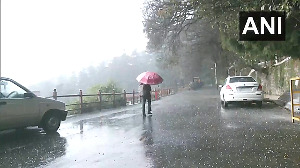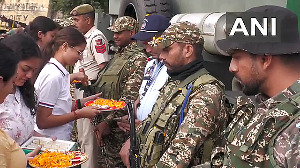In every imaginable way, Nafisaben is the antithesis of those who dream of transporting the Brahmaputra to Chhattisgarh. Unlike Mr Kannappan, she didn't begin by speaking of water or rivers; instead she spoke of communities, of gender-justice and women's empowerment, of freedom from moneylenders and government bureaucracies, of sanitation and health. Water security, she pointed out, is more than the mere technologies -- large or small -- that limit evaporation and contamination. Water must be primarily the community's property to manage for the public good, and the management of this precious resource must revolve around people's lives.
For two decades now, Nafisaben has led Utthan, a Gujarat-based non-profit organisation at the forefront of finding water security. In her world of vulnerable communities -- and especially their women -- water doesn't arrive by diktat over a government-funded pipeline. That dream was quickly defeated by memories of villagers scuffling over drops of water from pipes that fill underground tanks for 15 minutes a day, and standing guard over precious viradas -- pits in dry ponds that can yield two pots of water after a night-long vigil. Instead, her communities' water arrives ready-to-drink from the skies above and from the people's wisdom; all she must do is respect these and turn them to the fulfillment of the dreams they represent in entire communities.
Gujarat is dotted with evidence of Utthan's success. Beginning with Ahmedabad -- which now has a water self-reliance movement -- and then in Panchmahal, Mehsana, and along the shifting coasts of Bhavnagar and in Amreli, Utthan has facilitated the installation of rooftop water harvesting systems that feed into family-size storage tanks, replenished ground water and aquifers, and lined community storage ponds with plastic sheeting that prevents saline intrusions.
The remarkable thing is that Utthan's ideas for obtaining water security aren't radically activist or anti-government. In fact, for decades together, nearly every meaningful government document on the issue reads like a page from Utthan's manual. Repeatedly since the late 1970s, government policy has stressed decentralisation and community-specific initiatives, beating the drum of local ownership and control. The trouble has always been that reality hasn't squared with this policy; the government has failed to devolve power to local communities so that they may decide, plan, implement, maintain, and manage the use of their resource.
The bureaucracy is wedded to development paradigms that include a great role for itself, often with subversive intent. Nafisaben remembers a World Bank-funded pipeline built to deliver water to the Bhal region of Ahmedabad district's Dhandhuka taluka, but pilferage and other problems -- irregular electricity, unreliable ground water, etc -- led to the water being diverted away long before its intended terminus. The scheme, however, included a catch -- as a condition of the loan, the bank had insisted that users pay a fee for the water. Since the water wasn't being delivered, the government couldn't possibly collect any such fees. Nonetheless, the bank's funds were alluring to the administration; so for months together the government simply made up payments on behalf of users, in effect paying to borrow from the bank!!
Ms Barot doesn't have much faith in grand schemes. Her experience, she says, has been that those things don't work, for reasons that are quite plain. Without proper enforcement, pilferage is common. Borewells deplete ground water and lower the water table, forcing increasingly more and deeper bores to be dug; with increasing depth the likelihood of toxins in the water is greater as well. The planners behind these programs have little understanding of rivers; they have built few structures for storage, she says. They merely imagine that construction for transportation of water somehow equals progress. Their ideas do not address underlying social and economic barriers or questions of sustainability, they concern themselves with water as though it exists separate from the lives of communities that depend on it.
Not so in 'her' villages; there entire communities band together, often contributing their own labour to these efforts, and take pride in their ownership of the precious resource and its management for the public good. In this vision, where water isn't a saleable commodity but a social good, water security alone isn't the measure of success; accompanying improvements in awareness, women's rights, equity, and accountable governance are the true pillars of this progress.
Compared with the enormous complexities and socio-economic costs of large projects, such community programs for conservation appear more promising. Not only do they assure water security -- a claim many large projects are unable to make -- they additionally build civil society itself in myriad ways. Yet, these examples are dismissed out of hand, often on incredible grounds. Dr Kalyanaraman, for instance, insisted that such 'anecdotal' successes cannot be treated as useful pointers for a national effort. If Nafisaben had performed miracles in Cherapunji there would be some truth to this view; but in fact her fame -- as does that of Rajendra Singh in Rajasthan -- stems from efforts in deeply water-starved regions; surely success amid scarcity offers many lessons for other places.
Still, it is fair to ask if community-driven measures are adequate. Could it be that local water-harvesting, storage and management provide some measure of security, but large infrastructure projects are nonetheless necessary as well?
I posed this question to Nafisaben; indeed I tossed her an extreme version of it. "Can you imagine situations where, despite the success you have seen in local communities, the grand designs are in fact useful?" She didn't hesitate. "In 95% of the villages," she said, "community-based harvesting, groundwater recharging, protective storage, and conservation will be sufficient. The techniques applied will depend on the local conditions, but a combination of appropriate methods can surely meet the local needs."
Reflecting on the two meetings, I am struck by the parallels and the contrast. If their earnestness for doing good is any indication, Sam Kannappan and Nafisaben Barot are both good folks, as is Dr Kalyanaraman; there is little sense in contesting their obvious affection for India. But the greatest of good intentions nonetheless permits much room for opposition, and this must be why they offer such opposite imaginations of Indian water security. Our role, as interested citizens who may be similarly hopeful about the future, is to select between these imaginations.
The choice itself mirrors the divided ground of these different approaches. On one side we find organisational finance, technical capabilities for large projects, uniformity of management, and great political will in the face of extreme opposition from already disadvantaged communities. On the other side, we find local control, diversity of water-security measures, and the aspirations of those same people, that they too might find the promised economic and social freedoms written into the Constitution of our nation 53 years ago.
It is in considering the clearly social language of the latter that the choice is plain. The public good must begin with the people, not be foisted upon them in ways they oppose or reject. And it is here that the best intentions of Dr Kalyanaraman or Mr Kannappan encounter their fatal flaw. For their answer to the crying need is a very limited one. It offers local communities a condescending hand down from high offices of planning and finance, all the while promising to deliver a leg up. It fully recognises needs that must be met through enterprise, but is subversive of the methods by which local communities ask that the demands be met. It offers them water, while they additionally seek the opportunity to own and manage it.
The assertion that interlinking is the only meaningful solution to India's problems seems a poor beginning, for it accepts the defeat of all else. To imagine that $120 billion is the inevitable price of assuring water security, we must first accept that we are incapable of cheaper measures, that our people possess no wisdom for management of water within communities, that they lack every element of self-government and must therefore be fed and watered from afar. That label we cannot -- and must not -- accept. Far too much of Nafisaben Barot's life, and that of other fantastic leaders in local water management, speaks against this concession.
Our aspirations cannot be for India, they must be for the Indian people. Our ideas cannot be separated from the society whose advancement we seek. In our self-images, we must see not a market for grand technologies, not a socially broken nation that finds ability in the Saraswat and denies the imaginations of ordinary citizens in our villages. Our glory lies elsewhere. We must see the nation through the eyes of those who have made small promises and delivered on them, those who seek progress with the people, not merely in their name. We must learn to rejoice in those who have built small check dams in little hamlets, turned simple plastic sheeting into life-sustaining filters, and caught the rain on the roofs of countless homes.





